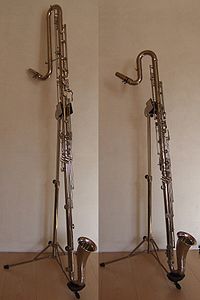- Contra-alto clarinet
-
The contra-alto clarinet is a large, low-sounding musical instrument of the clarinet family. The modern contra-alto clarinet is pitched in the key of EE♭ and is sometimes incorrectly referred to as the EE♭ contrabass clarinet. The unhyphenated form "contra alto clarinet" is also sometimes used, as is "contralto clarinet", but the latter is confusing since the instrument's range is much lower than the contralto vocal range; the more correct term "contra-alto" is meant to convey, by analogy with "contrabass", that the instrument plays an octave lower than the alto clarinet. It is the second-largest member of the clarinet family in significant use, larger than the bass clarinet but not as big as the BB♭ contrabass clarinet.
Like other clarinets, the contra-alto clarinet is a wind instrument that uses a reed to produce sound. The keys of the contra-alto are similar to the keys on smaller clarinets, and are played in the same way. Some contra-alto clarinet models have a range extending down to low (written) E♭, sounding as the lowest G♭ on the piano (aka G♭1), while others can play down to low C.
The earliest contra-alto clarinets were developed in the first half of the nineteenth century; these were usually pitched in F and were called contrabasset horns, being an octave lower than the basset horn. Albert (probably E. J. Albert, son of Eugène Albert) built an instrument in F around 1890.[1] In the late 19th and early 20th century contra-alto clarinets in EE♭ finally attained some degree of popularity.
The contra-alto clarinet is used mostly in concert bands and clarinet choirs, where it usually (though not always) plays the bass line of a piece of music. While there are few parts written specifically for it, the contra-alto can play the baritone saxophone part and sounds the same pitch; it is also possible to read parts written in the bass clef for instruments pitched in C (such as bassoon or tuba) as if the part were in the treble clef, while adjusting the key signature and any accidentals as necessary by adding three sharps to the music. It is occasionally used in jazz, and a few solo pieces have been written for it. The contra-alto clarinet is also a popular instrument in Broadway pit orchestras, with its parts being written in reed books as a doubler instrument e.g. with soprano clarinet and bass clarinet. The contra-alto clarinet can also be used in marching bands where it shares the parts of the sousaphone or baritone saxophone. However, because of its size and weight, many bands choose not to march them in parades.
Notes
- ^
 Chisholm, Hugh, ed (1911). "pedal clarinet". Encyclopædia Britannica (11th ed.). Cambridge University Press.
Chisholm, Hugh, ed (1911). "pedal clarinet". Encyclopædia Britannica (11th ed.). Cambridge University Press.
References
- Contrabass.com
- F. Geoffrey Rendall. The Clarinet. Second Revised Edition. London: Ernest Benn Limited, 1957.

This article relating to woodwind instruments is a stub. You can help Wikipedia by expanding it. - ^

